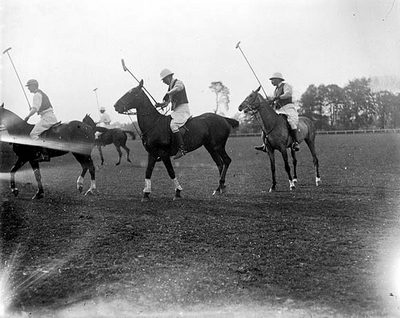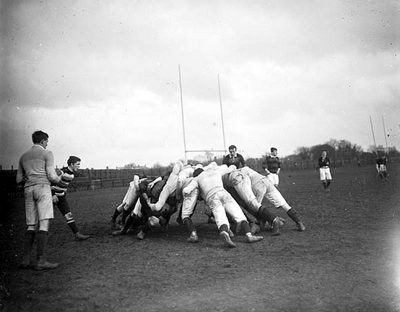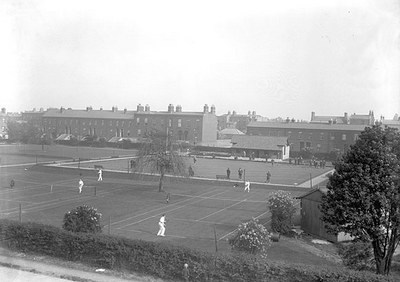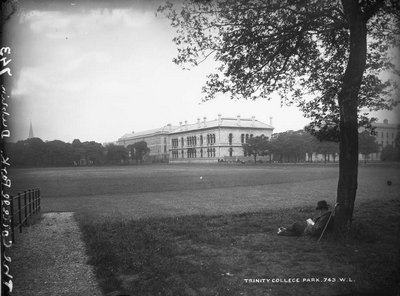Sport
View the photo galleryDublin did not develop professional sporting leagues like Belfast or the northern industrial cities of Britain, but amateur sport was a vital part of life in the city in 1911. Sport was played by all classes and in all areas, a remarkably diverse and increasingly prominent phenomenon across Dublin. Conspicuous displays of leisure were an integral part of the lives of wealthy Dubliners, with hunting, shooting and fishing expeditions, where sporting events were as much about social gatherings as about competitive endeavour.
The middle classes enjoyed the major elements of the Victorian sporting revolution, and games were an intimate part of suburban life in schools and clubs. Parts of that sporting revolution were adopted by the working classes. Older traditions also survived. Blood sports, despite being banned for almost a century, survived in working class areas where cock fights were a regular feature of life, especially around the Blackpitts in the south city.
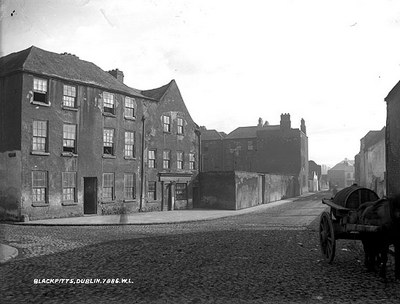
Cock-fighting was a regular feature of life in the the working class area of Blackpitts, photographed here c. 1880-1900
(NLI, LROY 7886)
Soccer was the most popular sport in Dublin. Following the spread of the game to Dublin in the 1880s, it quickly took root in the city. In 1911 there were 31 pitches in use in the Phoenix Park (see return for Park Constable John Connell); 29 of them were used for soccer, just two for gaelic football. Dublin teams, such as Bohemians, played against the professional teams of Belfast in the Irish League.
Bohemians, based at Dalymount Park were an avowedly amateur outfit, drawing heavily on past-pupils of Castleknock College, but Shelbourne Football Club turned professional in 1906 in an attempt to match the northern teams in the Irish League. Their success in winning the Irish cup that year brought huge celebrations in Ringsend and Sandymount, and they did it again in 1911, when victory was inspired by their best player, Val Harris of Erne St.
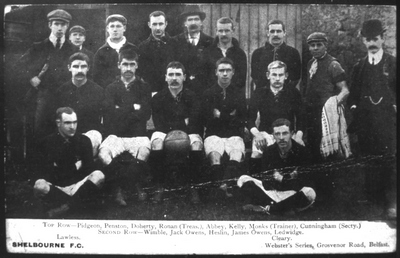
Shelbourne Football Club Team as they appeared in the Evening Mail, 5 March 1906. The club turned professional in 1906, winning the Irish league, a feat they repeated in 1911.
(DCLA, Dixon Slide 31.1)
If soccer was the most popular football game in the city, rugby was the longest established. Rugby in Dublin was the preserve of the prosperous middle classes, and Trinity College had the second oldest rugby club in the country. Among the many famous families who played for the club, the Clinches, Andrew and James were probably the best known. One of the founders of Bective Rangers Rugby Club, Harvey du Cros was also an Irish boxing and fencing champion, and was a central force in the promotion of cycle racing in the city with many races staged in the Phoenix Park. Along with another Dubliner, John Boyd Dunlop of Simmonscourt, he developed the world’s first pneumatic tyre company, having seen the potential of the invention at a cycling meeting.
Many important cycling and athletics meetings were held in the fields at Jones’ Road, just north of the Royal Canal. The grounds there had also been used for several years to play all-Ireland hurling and football finals, and were owned by Frank Dineen, a journalist. He later sold them to the Gaelic Athletic Association, who renamed the stadium as Croke Park in 1913. In 1911 the GAA was struggling to establish itself in the city, despite the fact that its headquarters and its most important stadium were based there. Many of the people who played hurling in the city’s clubs were originally from the hurling heartlands of Munster.
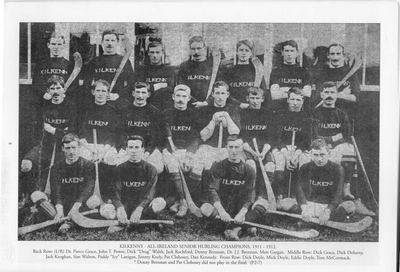
The Kilkenny hurling team, winners of the All-Ireland hurling title in 1911, 1912 and 1913
(GAA Museum)
The GAA’s secretary, Luke O’Toole, who served from 1901 to 1929, lived in Mount Pleasant Square, and his house was at one time the official headquarters of the association. The year 1911 saw the donation by Dr. George Sigerson, a professor at University College Dublin, of the Sigerson Cup for gaelic football, played for by the universities of Ireland.
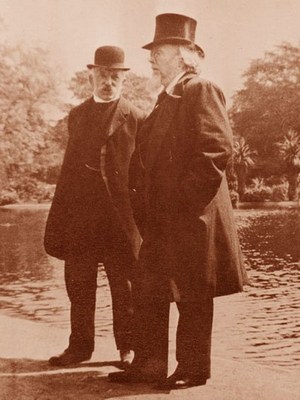
Dr. George Sigerson and DJ O'Donoghue in conversation on St. Stephen's Green
(Original photograph from the C. P. Curran Collection, UCD Library Special Collections. Digital image courtesy of the IVRLA, UCD)
If the GAA was eventually to prosper in Dublin, cricket was moving from being one of the most prominent games in Dublin to being a minority interest. Cricket had been played in Dublin as early as 1792, and in the mid-nineteenth century it was the most important game in city. It had, by now, been surpassed by other sports and cricket became a game largely (though far from exclusively) confined to the wealthier Dublin suburbs.
The most remarkable cricket story of 1911 was the presence in Woodbrook, south county Dublin, of a private cricket pitch owned by Sir Stanley Cochrane of Rathmichael, heir to the Cantrell and Cochrane soft-drinks dynasty. Cochrane built a private railway station at the ground, as well as an indoor cricket school, and employed several English professionals.
There were, in fact, a variety of cricket professionals living in the city, including John Keenan in Park Avenue, Sandymount and was attached to the local club. Cricket clubs were rarely independent ventures and were almost always part of a general suburban sporting club which included hockey, tennis, bowls and much else. Indeed, also living on Park Avenue in 1911 were two women in their mid-twenties, Mabel Surridge and Grace Patterson, who gave as their occupation ‘Secretary to Hockey club.’
Golf was also a growing interest for Dubliners. There were courses (see return for Frederick Wickham, caddy, of Cooldrinaagh, Lucan) in play all across Dublin and the first great Irish golfer, Michael Moran, was born on the North Great Bull Island. He dominated Irish golf, winning five successive championship from 1909, but besides Moran there were a surprising number of professional golfers across Dublin, living on their own or living as boarders (James Barrett of Carrickmines, and Thomas Monahan of Danespark). Equally surprising were the number of caddies in the city, particularly living in areas such as Clontarf, where William Leavy lived on Brian Boru Avenue, though not all were fortunate enough to be in employment, like Ernest Leslie at Prospect Avenue in Glasnevin.
One of the enduring features of the sporting world and of Dublin life was the presence of so many bookmakers, like Lawrence Mangan at Leo Avenue. These bookmakers were present at virtually every sporting event of note in the city. Some sports tried to ban them but, even then, betting survived on the fringes. Mostly, bookmakers plied their trade centre-stage (see return for O’Connell Gracepark Avenue). One of the most popular sports in Dublin in 1911 was billiards. There were billiard halls in many parts of the city (see return for Royal Marine Rd., Kingstown,), numerous hotels had billiard tables (see Waters return, Artane), and quite a number of men found employment as billiard markers (see return for Charles Kinsella, John Dillon St.).
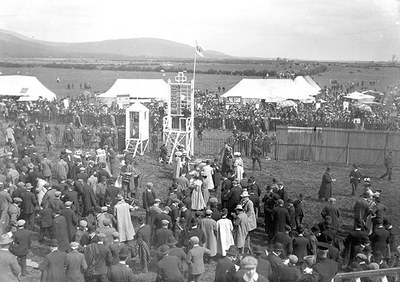
Spectators at an Irish race-track in the early 1900s. Rich and poor were united in their interest in horse-racing
(NLI, TEM 123)
Horse racing was one pursuit which united rich and poor, and had been given an added impetus by the development of the railways in the second half of the nineteenth century. There were centuries of tradition of race meetings in Dublin, notably in Crumlin and Baldoyle, and there were regular popular meetings at courses in the capital, including Fairyhouse and Leopardstown. Across Dublin there were horse trainers, like John Byrne of Pelletstown, Castleknock, and jockeys like Christy Symes, also of Pelletstown, as well as an entire racing infrastructure. For those with wealth, there was also a sporting world which was serviced by a variety of gamekeepers like Thomas Johnston of Howth Demesne.
The Victorian sports revolution and its aftermath is perceived largely as a male affair, but as sports were codified women were involved at various levels. The popularity of tennis, a sport traditionally associated with the wealthier classes, among women, suggests that women’s involvement in sport began in the upper classes. Upper- and middle-class women of those classes were also involved in hunting and horse-riding, and in hockey, tennis, swimming, camogie clubs and boat clubs (see return for Michael Cregan, boat club caretaker in Chapelizod).
Agnes O’Farrelly, Úna Ní Fhaircheallaigh, one of the early graduates of the Royal University of Ireland, was a lecturer in modern Irish in UCD from 1909. She later became the professor of Modern Irish Poetry on the retirement of Douglas Hyde. O’Farrelly founded the UCD Camogie club and convinced William Gibson, 2nd Lord Ashbourne, to present a cup for the intervarsity Camogie Championships which is still played for.
Women also used the many bathing houses which operated in Dublin, with many of the pools having a central wall dividing the pool into space for men and for women. There were the Seapoint Baths, the Merrion Pier and Baths which were on Sandymount Strand, east of the Martello tower, and the Clontarf Baths and Assembly Rooms which were fitted with heated seawater baths. A remarkably vibrant swimming association existed in 1911. The Irish championships were dominated by the sons of Sir Maurice Dockrell from Monkstown. Henry Morgan Dockrell captained the Irish water polo team and won six Irish titles. George Shannon Dockrell then took over and was recognised as the best swimmer of his generation, winning 20 Irish titles.
Another prominent swimmer was the distinguished doctor, writer and wit, Oliver St. John Gogarty, of Ely Place. Gogarty also played soccer with Bohemians FC and competed regularly in the Irish cycling championships. All-round sportsmen such as Gogarty were a staple of life in Edwardian Dublin. Pride of place must go to George Francis Fitzgerald, a maths physicist based at Trinity College. Fitzgerald was an outstanding oarsman, a champion pole-vaulter and a hurler. He also tried to fly in 1895 using a winged-contraption and a runway against the Pavilion in College Park.

